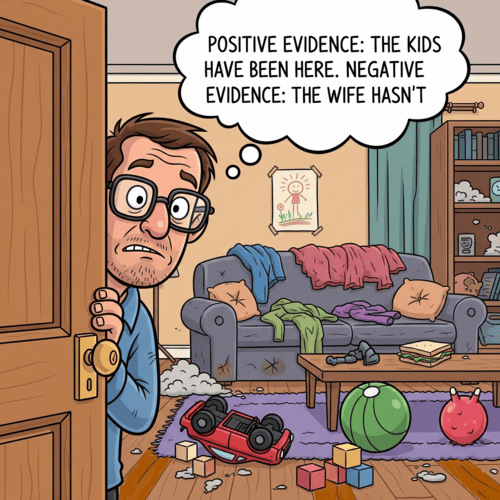The Negative Evidence Against Materialism: 5 Powerful Examples
Sometimes what’s missing tells us more than what’s there. When Sherlock Holmes noticed the dog that didn’t bark in the night, he solved the case precisely because something expected was absent. This same principle applies to one of the most powerful arguments for God’s existence: negative evidence.
In our scientific age, many assume materialism—the belief that only matter and energy exist—represents the rational default position. But what if the evidence points in the opposite direction? What if the very things materialism predicts should exist are conspicuously absent from our universe?
WHAT IS NEGATIVE EVIDENCE?
Negative evidence isn’t “bad” evidence as some suspect—it’s evidence based on meaningful absence. When a theory predicts certain phenomena should exist, but we consistently find nothing where something should be, that absence becomes powerful evidence against the theory.
Think of it like this: if someone claimed invisible elephants lived in your backyard, you’d expect to see footprints, disturbed vegetation, and elephant droppings. The complete absence of these predicted signs would be strong evidence against the invisible elephant theory. Similarly, if materialism were true, we should observe certain things consistently throughout nature. The fact that we don’t tells us something profound about the nature of reality.
This approach has strong scientific precedent. The absence of the “luminiferous aether”—a substance scientists predicted must exist if light travelled in waves—helped prove Einstein’s theory of relativity. Sometimes what’s not there reveals more truth than what is.
FIVE POWERFUL EXAMPLES OF NEGATIVE EVIDENCE AGAINST MATERIALISM
1. The Absence of Gradual Consciousness
If consciousness emerged purely from brain complexity, we should find evidence of partial consciousness or “consciousness gradients” throughout the animal kingdom and in simpler systems. Materialism predicts a smooth spectrum from unconscious matter to full consciousness.
Instead, consciousness appears as an all-or-nothing phenomenon. Despite decades of neuroscience advances, we find no evidence of “halfway conscious” systems. The famous “hard problem of consciousness”—explaining why we have subjective experience at all—remains completely unsolved by materialistic approaches. This absence of gradual emergence points to consciousness as something fundamentally different from mere matter.
2. The Missing Moral Evolution
Pure evolutionary materialism predicts that moral standards should constantly evolve and improve over time, varying dramatically across cultures based on survival advantages. If morality is just evolutionary programming, we’d expect to see radically different moral systems and continuous moral “upgrading.”
Reality presents the opposite picture. Core moral intuitions remain remarkably stable across cultures, times, and peoples. Universal prohibitions against unprovoked killing, requirements for fairness, and appreciation for self-sacrifice appear everywhere. Most puzzling for materialists: humans regularly act against their survival interests for moral reasons, helping strangers and even enemies. This moral consistency across cultures suggests a transcendent moral source rather than mere evolutionary accident.
3. The Absent Mathematical Necessity
Pure materialism cannot explain why mathematical principles should govern physical reality at all. If the universe is just matter in motion, there’s no materialistic reason why it should follow elegant mathematical laws or be comprehensible to human minds.
Einstein himself marvelled at this puzzle: “The most incomprehensible thing about the universe is that it is comprehensible.” Mathematical beauty, simplicity, and precision pervade everything from quantum mechanics to cosmology. This mathematical elegance points beyond mere matter to an intelligent source that structured reality according to rational principles.
4. The Information Problem
DNA contains complex, specified information—detailed instructions for building and maintaining life. Materialistic processes should generate such information naturally and abundantly if life arose without intelligence.
Instead, we observe the opposite. Random mutations combined with natural selection can only preserve or degrade existing information—they cannot create new, complex instructions. Every attempt to demonstrate information arising without intelligence has failed. This absence of a materialistic mechanism for information generation points strongly toward an intelligent source for life’s complexity.
5. The Fine-Tuning Silence
Materialistic models predict a chaotic, life-hostile universe where physical constants would vary randomly. We should find a cosmos indifferent to life’s requirements.
Instead, we discover precise calibration of universal constants that make life possible. The strong nuclear force, electromagnetic force, and dozens of other parameters exist within incredibly narrow ranges that permit stars, planets, and ultimately life. The absence of any materialistic explanation for this fine-tuning (multiverse theories lack evidence and simply push the question back one step) points to intentional design.
ADDRESSING COMMON OBJECTIONS
Critics often dismiss these arguments as “God-of-the-gaps” reasoning, claiming science will eventually fill these holes. But this misunderstands negative evidence. These aren’t gaps in our knowledge—they’re areas where materialism makes specific predictions that consistently fail to materialize.
The difference is crucial: a gap suggests we simply don’t know yet, while negative evidence shows us naturalistic explanations actively contradict observed reality. When multiple independent lines of evidence all point away from materialism, the cumulative case becomes compelling.
THE BROADER EVIDENCE LANDSCAPE
The negative evidence complements positive evidence for theism. While negative evidence shows materialism’s failures, positive evidence actively supports God’s existence through cosmological arguments (the universe’s beginning), teleological arguments (design in nature), historical evidence for Christ’s resurrection, and personal religious experience.
Together, these approaches demonstrate Christian faith isn’t belief despite evidence, but faith supported by multiple converging lines of evidence.
THE NEGATIVE EVIDENCE : WHY THIS MATTERS
Understanding negative evidence equips believers to engage confidently with materialistic assumptions prevalent in academia and culture. It shows how Christianity aligns with reality at the deepest levels and provides an accessible entry point for meaningful conversations with thoughtful sceptics.
The evidence—both what’s there and what’s missing—points not to a universe of mere matter and motion, but to one grounded in mind, meaning, and purpose. Sometimes the most powerful evidence is precisely what’s not there.
THE NEGATIVE EVIDENCE: RELATED FAQs
Who coined the term “negative evidence” in apologetics? While the logical concept of arguing from absence has ancient roots (Aristotle discussed it as “argument from silence”), the specific term “negative evidence” in Christian apologetics was popularized by philosopher and apologist JP Moreland in the 1980s and 1990s. Moreland, a prominent philosopher, systematically developed this approach in his debates with materialists, showing how the consistent absence of materialism’s predicted phenomena creates a powerful cumulative case for theism.
- How does negative evidence differ from the classic “argument from ignorance” fallacy? This is a crucial distinction. The argument from ignorance fallacy concludes something is true simply because it hasn’t been proven false (“We can’t prove aliens don’t exist, therefore they do”). Negative evidence, however, identifies specific predictions that a theory makes and demonstrates their consistent absence despite extensive investigation. Materialism, for instance doesn’t just fail to explain consciousness—it predicts consciousness should emerge gradually through increasing complexity. After decades of neuroscience research specifically looking for this gradual emergence, we find no evidence of it anywhere. This isn’t arguing from ignorance but from the absence of predicted phenomena after thorough investigation.
- Which Christian apologists have made the most compelling cases using negative evidence? William Lane Craig uses negative evidence in his debates on the fine-tuning argument, demonstrating how multiverse theories fail to predict the specific constants we observe. Stephen Meyer employs it powerfully in Darwin’s Doubt, showing how neo-Darwinism predicts gradual fossil transitions that are consistently absent from the geological record. Edward Feser uses negative evidence philosophically, demonstrating how materialism fails to predict the rational reliability of human thought. John Lennox applies it to information theory, showing how materialistic processes consistently fail to generate new specified complexity. Michael Behe uses it in biochemistry, highlighting the absence of gradual pathways to irreducibly complex systems that Darwinism predicts should exist.
- Can negative evidence be quantified or measured scientifically? Yes, in several ways. Information theory provides mathematical tools to measure the improbability of complex specified information arising without intelligence—calculations that consistently show astronomical odds against materialistic origin. Statistical mechanics can calculate the probability ranges for fine-tuning parameters. When we find constants calibrated to 1 part in 10^60 or more precise, the mathematical improbability becomes scientifically meaningful. Fossil record analysis quantifies the absence of transitional forms. Palaeontologists can statistically model what gradual evolution should produce versus observed patterns of stasis and sudden appearance. Consciousness studies use measurable criteria like integrated information theory to search for gradual emergence—consistently finding discrete thresholds rather than smooth transitions.
How do materialists typically respond to negative evidence arguments? Materialists employ several standard responses, each with inherent weaknesses:
“Science of the gaps”: They argue future discoveries will fill these absences. However, negative evidence often grows stronger with additional research (like consciousness studies), making this response increasingly implausible.
“Different methodological approach needed” They claim these phenomena require new scientific methods. This essentially admits current materialistic methods are inadequate while offering no concrete alternatives.
“These aren’t real problems”: They dismiss consciousness, meaning, or information as illusions. This requires them to deny the very phenomena that demand explanation—a form of intellectual escape rather than engagement.
The pattern reveals materialism’s inability to engage these challenges substantively, often resorting to promissory notes or definitional solutions.
- Does negative evidence work equally well against all forms of atheism? No, it’s specifically powerful against materialistic/naturalistic atheism—the dominant form in academic and popular discourse. This worldview makes specific, testable predictions about reality that consistently fail to materialise. The more specific and materialistic the atheistic worldview, the more vulnerable it becomes to negative evidence.
- What’s the strongest single piece of negative evidence against materialism? While the cumulative case is most compelling, many apologists consider the absence of any materialistic mechanism for generating complex specified information the single strongest piece of negative evidence. Here’s why: information is measurable, ubiquitous in life, and absolutely essential for biological systems. Yet despite extensive research, no undirected material process has ever been observed creating new complex specified information. Random processes destroy information, and natural selection can only work with information that already exists. As computer scientist David Berlinski notes, this isn’t a gap in our knowledge—it’s a fundamental contradiction between what materialism predicts should happen and what we consistently observe does happen. The absence is both universal and mathematically quantifiable, making it devastating for materialistic worldviews.
THE NEGATIVE EVIDENCE: OUR RELATED POSTS
Editor's Pick

Why Do People Hate the Doctrine of Election?
…WHEN THEY REALLY SHOULDN’T Few Bible doctrines provoke stronger reactions than election. The idea that God chose some for salvation [...]

The Doctrine of Providence: Does God Really Govern All Things?
You’re sitting in the doctor’s office when the diagnosis lands like a thunderclap. Your mind races: Why this? Why now? [...]

No Decay, No Defeat: What It Means That Christ’s Body Saw No Corruption
On the Day of Pentecost, Peter stood before thousands and made a startling claim: David's body decayed in the tomb, [...]
SUPPORT US:
Feel the Holy Spirit's gentle nudge to partner with us?
Donate Online:
Account Name: TRUTHS TO DIE FOR FOUNDATION
Account Number: 10243565459
Bank IFSC: IDFB0043391
Bank Name: IDFC FIRST BANK






